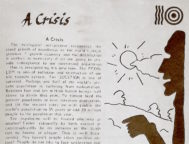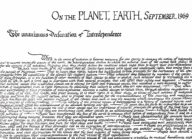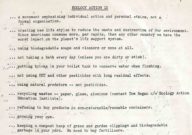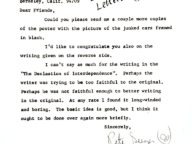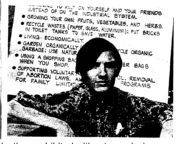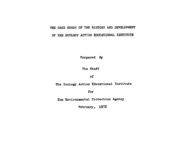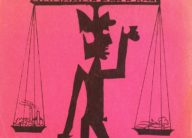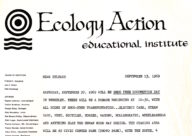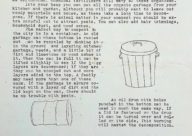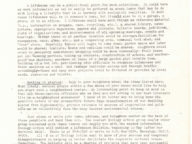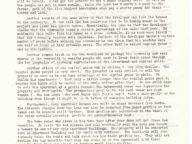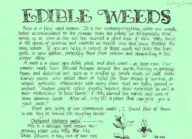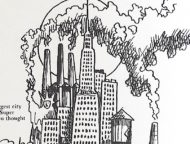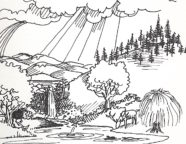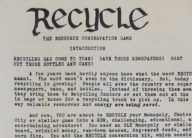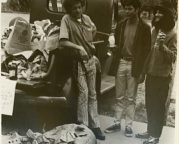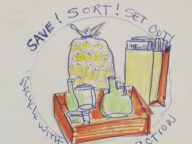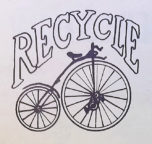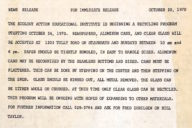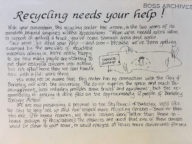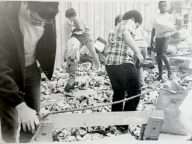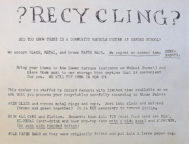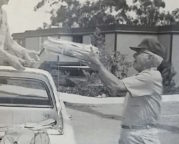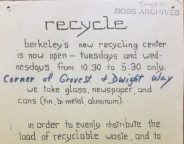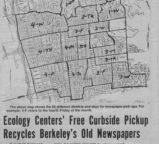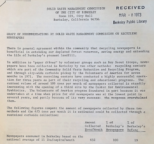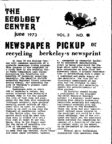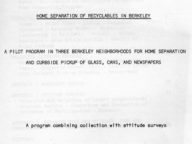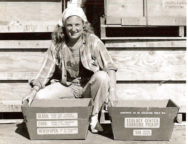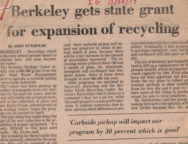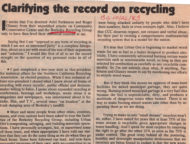The Secret History of Recycling
Today recycling is ubiquitous. Blue recycling containers are everywhere—by residential curbsides, next to our garbage receptacles at home, and in public spaces like parks, schools, and courthouses. We see the big business of recycling: trucks adorned with branded logos, collecting recyclables left by the curbside. We see the small business of recycling too: those — sometimes stigmatized as “poachers” — who push shopping carts stuffed with recyclables down residential streets.
Where does this split — between official recycling and unofficial recycling — come from? And where does recycling itself come from? One answer to those questions takes us to a house on Benvenue Avenue in South Berkeley, where the Ecology Action collective laid out a new path for the environmental movement.
Ecology Action: A New Player in the Environmental Movement
Recycling did not start as something of itself; it was a product of the Ecology Action movement, which itself grew out of the antiwar movement. In 1966, Cliff Humphrey’s stepson asked him to listen to a speech by Oregon Senator Wayne Morse on the Vietnam war. Morse’s speech inspired Humphrey to become involved in the peace movement in Southern California and educate himself further about the war. At the same time, he also decided to attend college in the Bay Area.
At Oakland’s Merritt College (the same community college where the Black Panther Party had earlier formed) Humphrey found his passion for activism fusing with the new theoretical knowledge he’d gained from courses in economics, political science, and anthropology. Humphrey wrote an essay on the relationship between nature, society, and the people of a native American tribe—their ecology—and he became especially interested in thinking ecologically, about the interconnectedness of Earth and humans. (These meditations later gave birth to Ecology Action’s founding document, “The Unanimous Declaration of Interdependence”).
After Humphrey met Chuck Herrick at a political meeting, they chose to create, within the Peace and Freedom Party, an ecology caucus. They hoped that the Peace and Freedom Party, a progressive alternative to the Democratic Party, would incorporate the idea of ecology into its platform. When that effort failed, Herrick and Humphrey launched Ecology Action as a standalone organization.
Out of the noise of the time— war, inflation, assassinations, civil unrest — was born a new offshoot of the environmental movement. In a lengthy New York Times Magazine profile, Steven Roberts framed the difference between Ecology Action and mainstream environmentalism this way: “If the Sierra Club is the N.A.A.C.P. of the environmental groups, Ecology Action is a cross between SNCC and the Yippies.” (The NAACP was understood to be more respectable and oriented toward legal action; SNCC and the Yippies, more youth-driven and dramatic in their grassroots activism.)
Roberts’s comparison was a good one: Ecology Action’s ethos was indebted to the more radical edge of the civil rights movement and its insistence on the importance of “direct action.” While the Sierra Club and the Bay Area’s Save the Bay were galvanized by the issue of conservation and, in their membership, drew upon more affluent sponsors, Ecology Action tended to be more brash, urban-oriented, and demanding in its activism.
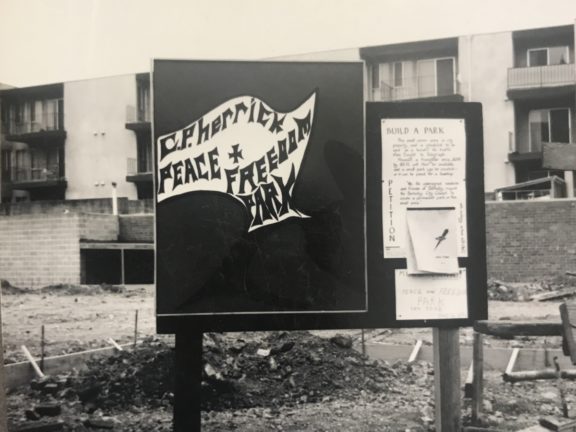
The first “People’s Park,” created by Ecology Action to honor Chuck Herrick (Ecology Action collection, Bancroft Library)
When Herrick died in a tragic automobile accident while traveling to the national meeting of the Peace and Freedom Party, Cliff Humphrey and his wife, the artist Mary Humphrey, decided to commemorate Herrick’s life. Two days after his death, they did so using the tactics of direct action that he supported: Ecology Action’s first action was the occupation of a vacant lot, at the corner of Dwight and Telegraph, so as to build a park that Herrick had imagined.
Volunteers turned the lot into a green space, and for several weeks, Ecology Action served free soup and bread to those who stopped by. The park was to be a place for the exchanging of ideas, and because of the proximity to walking folks, it became just that. As Berkeley historian Tom Dalzell has suggested, the park in Herrick’s honor was Berkeley’s first “people’s park”.
Ecology Action Takes Root and Spreads the Word
Ecology Action’s actions were many and memorable. The group read their founding statement of principles, “The Unanimous Declaration of Interdependence,” at Berkeley’s city dump, surrounded by supporters and a pile of fish that had been killed at Aquatic Park. They sponsored an ecology fair, at which the Humphreys, along with a large group of volunteers, destroyed their family’s car to underline how the combustible engine was detrimental to our environment and to prove to the public their commitment to the cause.
In fall 1969, the group proclaimed September 27 to be Smog-Free Locomotion Day—which it celebrated by dramatically burying a combustible engine and hosting a parade of alternative options of transportation (“electric cars, steam cars, feet, bicycles, horses, wagons, rollerskates, wheelbarrows, and anything else the human mind may design”), capped off by six hours of joyful live music.
These demonstrations and events had an educational aspect that was amplified by the many leaflets and booklets that the organization turned out from its communal home at 3029 Benvenue Avenue, in South Berkeley. The Humphreys were joined by a number of dedicated environmental activists, many of whom were conscientious objectors who were allowed, by the state of California, to fulfill the terms of their community service by volunteering for Ecology Action.
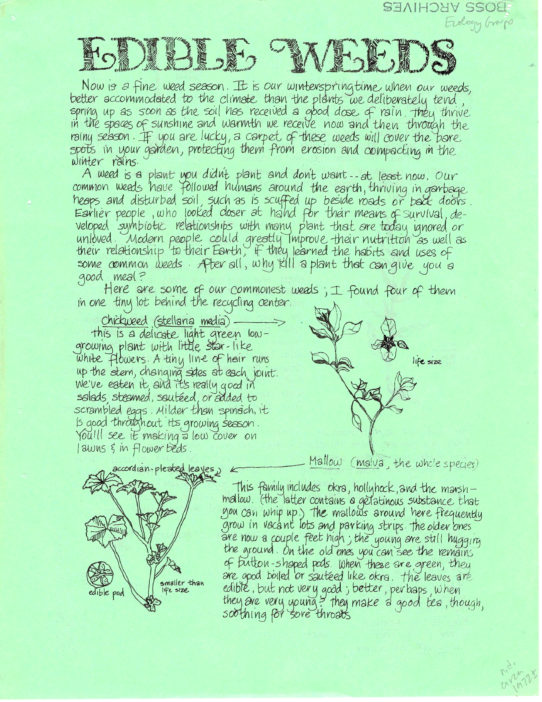
“Edible Weeds”: seeing the urban landscape through fresh eyes
Ecology Action generated flyers about soil, about composting, about edible weeds. It analyzed the costs of runaway development, and offered advice on how to create an ecological “lifehouse” in your own neighborhood. It published a step-by-step guide for how to create a neighborhood recycling center, and acted on its own ideals by launching its own fledgling recycling project with the Berkeley Co-Op.
Behind all this literature was a philosophy of what Ecology Action was. It was not a top-down organization but a grassroots hub of ecologically-minded action and education; it was about creating alternatives to profit-oriented capitalism and convenience-oriented consumerism.
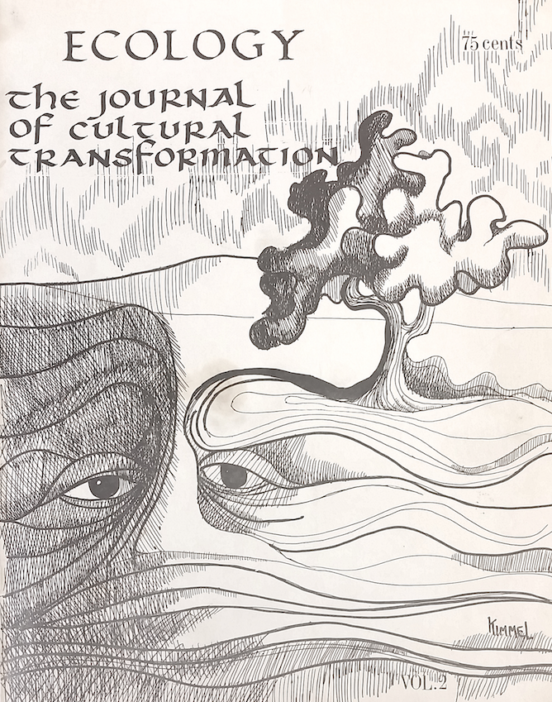
The cover of Ecology, vol. 2 (1970), published by the Ecology Action Educational Institute
Recycling was just one of many issues in which Ecology Action had a stake: its concerns about the environment reached further than the Sierra Club’s then-focus on conservation and the protection of the environment. The overarching problem that Ecology Action diagnosed was the problem of our collective social and cultural values, and of the desires they produced — the desire to dominate nature and the longing for material possessions. Ecology Action aimed, through education and action, to change people’s values and mitigate our demands for products and goods, so that we might live in greater harmony within our environment.
As Ecology Action took on a wider range of issues — from overpopulation to the ills of capitalism to recycling and composting — and as it generated publicity through its actions, it began to attract national notice. Many Ecology Action-type groups formed around the country as a result of the publicity and a common interest in the environment.
Ecology Action Seeds Recycling in Berkeley
In 1970, Ecology Action’s recycling center was in disarray. People were crowding in the space, forming a sore semblance of a line as they waited to drop off their recyclables. The yard was packed with piles of sorted and unsorted material. It smelled of old unwashed beer bottles and wet cardboard. It was noisy with chatter, the breaking of glass, and continuous crunching of cans.
Ecology Action’s twelve members tried to get to all their visitors, to engage with them while processing and preparing the materials for transfer to a buyer, but they could not handle all the recycling materials they were receiving. While excited to see such high interest in recycling, they did not have the capacity to handle such enthusiasm. In a flyer they declared, “Recycling needs your help!” By ‘help’, they did not mean that they needed more people to recycle; rather they wanted people to make the need for more recycling centers known to city officials. The city of Berkeley needed, by their lights, to support the building of more recycling centers so as to accommodate demand.
Ecology Action envisioned that their site would be a place for recycling and for informing the public about ecology. They wanted to be able to engage with each visitor — to thank them for choosing to recycle, correct their sorting/preparation mistakes, suggest other ways they could reduce their impact on the earth, and teach about zero waste. After all, their goals went beyond recycling. They wanted to eliminate waste as much as possible so as to preserve the earth, not to encourage the recycling of materials that should not have been made in the first place. The issue of waste opened up, that is, onto a larger social and environmental issue. Ecology Action saw the center as an opportune venue to attack the destructive and materialistic ideologies that made recycling such an environmental necessity.
For Berkeley, they imagined a system of recycling centers across the city, where residents would take their recycling when they were ready. They believed that a system of centers, another proposed method in other cities, worked better than curbside pickup because they could engage with people directly and promote further education. It was meant to be an active rather than passive system.
The idealists of recycling, Ecology Action, wanted to use as much human labor as possible in the act of recycling, instead of producing additional pollution through the use of machinery. Such idealism is displayed in their publication, How to Start a Neighborhood Recycling Center. Colored bottles were separated by hand, glass was crushed using a weighted metal bar in a drum barrel by hand, and trucks were loaded not by forklift, but by hand. It was a manual labor-intensive team effort which took a lot of time — no wonder they were overwhelmed! By asking the public to reduce their impact through recycling, they felt it was their duty to have as little environmental impact as possible in the processing of recyclables. Turning recyclable material into new products used enough energy as it was. As recycling became a formalized system in Berkeley, however, these ideas were not sustained because they were not in the interests of cost efficiency.
The publications of Ecology Action are critical to understanding recycling—what it was, originally; the motives behind it; and how it developed. Each document follows a similar pattern, first presenting the environmental problem and then offering sound alternatives. They used fun graphics to break up their text-heavy documents and wrote in a simple and intimate way.
The organization’s correspondence with the larger community was critical to disseminating ideas about ecology. While immediately important to Berkeley, they also set a precedent for ecology across the country. In 1969, a UC Berkeley library representative asked to receive their publications to document the important social change work they were doing. This was one of many letters from educational institutions requesting to be added to Ecology Action’s mailing list.
Ecology Action’s Founders Take a Survival Walk — and Transplant Themselves to Modesto
In late 1969, Cliff and Mary Humphrey wondered how it might be possible to spread ecological thinking beyond Berkeley, and beyond those parts of the Bay Area that resonated with a Berkeley mindset. Convinced of the links between the environmental crisis in cities and the environmental crisis in agricultural areas, they conceived a “survival walk” from Sacramento to Los Angeles, one that traversed California’s agriculture-oriented center.
Starting in March 1970, about 50 Ecology Action members began the Survival Walk, trailed by propane-powered vehicles that carried materials for ecology fairs, puppet shows, and the like. Across the San Joaquin Valley, they hosted around twelve “Eco Festivals” for the locals, seeding environmental groups along the way.
Most consequentially for Ecology Action itself, Cliff and Mary Humphrey took a liking to Modesto and decided to move the Ecology Action Educational Institute to the city, with a commitment to make it into “an example of environmental sanity.” This was a cause which the Humphreys, in typical fashion, threw themselves into — working, for example, with Gallo wineries on a large-scale glass recycling program and enjoining the city to develop a municipal recycling program.
Back in Berkeley, those who had been affiliated with Ecology Action looked to continue the organization’s work. The Humphreys’ departure from Berkeley was unusual because so many of the publications they developed implied a desire to further develop recycling in Berkeley, not to leave. As it happened, they anticipated a city-wide program, but departed before they could be involved in planning it.
After Ecology Action: the Co-Op Recycling Center and the Ecology Center
After the departure of the Humphreys, a group of Berkeley’s Ecology Action alums formed the Co-Op Recycling Center and continued Ecology Action’s operation. This site had lots of space and was visible to the community near the intersection of Sacramento Street and University Avenue. These former Ecology Action members worked to answer Berkeley’s need for a recycling center and continued to produce some publications, though not to the degree of their predecessor.
The Ecology Center, meanwhile, was becoming an important hub for the environmentally conscious. Early Ecology Center staffer Karen Picket explained, in “Ecology Emerges,” “A lot of people got their start being turned on to other people, resources, and ideas at the Ecology Center, and went on to do other things. The Ecology Center never ‘owned’ much of anything in terms of campaigns and issues, but was a resource and a springboard. A lot of people that worked on styrofoam or plastic issues, or started community recycling centers, or brought projects into the schools, or started community garden groups, or creek restoration groups, wouldn’t necessarily credit the Ecology Center because there was a general sharing of ideas without ownership, but if those seeds hadn’t been planted back then, I don’t think we would be where we are now.”
It is easy to confuse the names of The Ecology Center and Ecology Action because the work they did was so similar. For both, recycling was just a piece of a much larger movement about going back to nature, educating the community about ecology, and pushing back against capitalism, materialism, conformity, and the inequality of popular culture through simple living. Several smaller, informal recycling programs existed through schools, concerned neighbors, and as fundraisers for community groups like the Boy Scouts.
In its early years, the Ecology Center was made up of countercultural youth, student volunteers, and conscientious objectors avoiding the draft. Kathy Evans and her boyfriend, a conscientious objector, started out as volunteers at the Ecology Center. Evans became the director, and during her twenty years heading up the Center, she steered its evolution from a casual space of ideas to an effective non-profit organization that handled the city of Berkeley’s curbside recycling, among other projects.
Early Efforts to Coordinate City-wide Recycling
The need and public desire for a city-wide recycling system was recognized by the city of Berkeley, but the city was hesitant to spend money on a new program. Instead, the city preferred to reduce costs by contracting out to an outside organization. The Ecology Center made themselves a viable choice. In 1973, the Ecology Center began curbside pickup of old newspapers in Berkeley. Other groups had experimented with curbside but none were as ambitious. The program was free, covered all of Berkeley, and collected on a monthly basis. Newspaper was estimated to be 20% of the total waste going to the garbage dump so it was prioritized as the first material to be recycled.
One year into the program, the volume of newspapers collected was a fourth of what had been expected, putting the program in debt. The cost of trucks, labor, and materials couldn’t pay for itself from the sale of the recycled newspaper. The Ecology Center needed residents’ participation and education.
For those who were pushing back against materialism or affiliated with the environmental movement, recycling was an exciting way to take immediate and tangible action. They saw how materialism and capitalism encouraged people to buy more things to feel satisfied, then to throw away that which was no longer satisfying, even if it was still useful. This dynamic created enormous amounts of waste: there were the layers of packaging for those new things; the old stuff that was being thrown away; and the waste from the creation of those new products. Whenever they went to Ecology Action’s drop-off center, they could see the impact they were making through the piles of recyclables that were being collected.
For many others in the community, recycling did not have a clear incentive behind it. Why should you recycle if it is of no financial or material benefit to you? Ecology is an abstract concept because it thinks on a global level. How can a small stack of newspapers from one household benefit the health of the planet? It is easier to throw all the waste in one bin than to think about separating it. People throw things away all day long in their home. Recycling asks them to do something extra in their private space, because it is the right thing to do. The action springs from a moral question, one posed by the environmental movement in the 1970s: do you want, through a small but constant commitment, to participate in making a healthier planet?
For some residents, recycling was an economic decision. Low-income households often collected and saved their own recyclables to sell. As a consequence, they were not interested in giving them for free to the city and Ecology Center. They were also more likely to be frugal with their resources, re-using or re-purposing something instead of throwing it away: they generated less waste, so had less to recycle. In 1976, a study by the League of Women Voters conducted a pilot program and interest survey with the community in three Berkeley neighborhoods of different socioeconomic groups. The people from West Berkeley, primarily people of color, were less likely to recycle compared to the people from the Berkeley hills, who were eager to participate.
The Ecology Center’s program was also in competition with people who made their income by collecting recyclables. These people, labeled by some as “poachers,” collected material from public places and the neighborhoods, eventually dipping into the recycling bins — and thereby taking away from the Ecology Center’s income.
Because recyclables have a monetary value, there are often class-related complications to the practice of curbside recycling. To those who don’t need the money, recyclables are an inconvenience. They are considered garbage so people are willing, essentially, to donate them. To those who needed the money, recyclables are a potential source of income. This remains an unresolved issue. People who push shopping carts down the street searching for cans, or fill trucks high with cardboard, are still considered poachers.
Working Out the Kinks: City-Wide Recycling Develops a Business Model
Berkeley did indeed make the shift to recycling in due time. In 1979, the Ecology Center won a grant to expand recycling. A newspaper article on the matter described recycling as “second nature to residents.” Through education and fun incentive programs, the Ecology Center bolstered participation in curbside recycling. During the later-’70s, recycling became industrialized. Larger organizations carved out spaces for themselves in Berkeley recycling, and the informal programs disappear from the archive.
As the recycling movement became the recycling industry, the ethos around recycling changed. The idealism found in Ecology Action — where recycling was part of a larger turn away from profit-making — becomes submerged as a theme, and the more prominent issues are money-oriented: cost efficiency and competition between organizations.
The Ecology Center’s $900,000 grant allowed them to expand the program. They collected paper, glass, and cans on a weekly basis, replacing the monthly curbside service. Two other curbside programs existed at the time, one of which was a paid service. As a result of the expansion, the Ecology Center displaced other recyclers. Poachers also became of greater concern to the Ecology Center, which at one point distributed a flyer asking residents to report poachers to the police if they saw them in their neighborhood—a rather severe reaction, but indicative of the tensions over recyclables as a resource of value.
The City of Berkeley became invested in increasing recycling in large part because it wished to extend the life of the city-owned garbage dump. Located behind Golden Gate Fields, the ex-dump is now the treasure-filled Albany Bulb. Before the recycling efforts of the 1970s, everything went into the landfill. Recycling diverted a substantial amount of material from the dump. As the garbage dump filled, Berkeley had to come up with a new plan for handling waste. Community Conservation Center (CCC) emerged from the Ecology Center as its own non-profit and became an important part of the recycling in Berkeley. They took over the Co-Op’s operations and managed two other sites. In the new city plan for waste, CCC proposed to operate the new facility, the transfer station. There, waste would be further separated out between reusable and recyclable materials before being loaded into dump trucks.
Recycling in Berkeley is a success but, in part, it has become exactly what Ecology Action feared—a self-perpetuating business. The efforts and ideology of the 70s laid the groundwork for the recycling system we have in Berkeley today. The Ecology Center and CCC, as non-profits, keep resources in the local community, support education, and have high standards because they are not profit-driven. That does not stop recycling from being a business, out to make a profit and keep itself going. Ironically, now that recycling has proven its monetary value, there are arguably fewer incentives to reduce the creation of waste that is recyclable or not.
Ecology Action’s original vision, meanwhile, was to use recycling as a step towards a zero-waste society. No paper, no glass, no plastic would be made without the intention of being reusable. Reuse. Reduce. Recycle.
— Brandon Redmon and Abigail Sotelo
Sources Referenced
Berkeley Recycling, “Our History,” Community Conservation Center. berkeleyrecycling.org, 13 April 2018.
Ecology Action Educational Institute, “The Case Study of the History and Development of the Ecology Action Educational Institute,” National Service Center for Environmental Publications (NSCEP), April 29, 2018.
Ecology Center, “Our History,” Ecology Center, April 13, 2018.
Clifford Humphrey, “Doing Ecology Action,” in Ecotactics: The Sierra Club Handbook for Environmental Activists, ed. John G. Mitchell (New York: Trident Press, 1970), 67-73.
Additional Reading
Peter Berg, Beryl Magilavy, and Seth Zuckerman, A Green City Program for San Francisco Bay Area Cities and Towns (San Francisco: Planet Drum Books, 1989).
Chris Carlsson and Lisa Ruth Elliott, “Ecology Emerges,” in Ten Years That Shook the City: San Francisco 1968-1978 (San Francisco: City Lights Foundation Books, 2011), 241-256.
Clifford C. Humphrey, Back to the Bike (San Francisco: 101 Productions, 1972).
Keith Makoto Woodhouse, The Ecocentrists: A History of Radical Environmentalism (New York: Columbia University Press, 2018).

Ecology Action's suggestions for how to flatten cans and load recycling materials with "non-polluting human muscle power" ("How to Start a Neighborhood Recycling Center")
